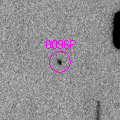
|
Brightening rapidly. It has brightened up to 16.5 mag on June 1 (Martin Masek, et al.). Marco Goiato reported it was 12.1 mag visually on June 17. It will approach to the sun down to 0.12 A.U. on July 14. In the Southern Hemisphere, it keeps observable in good condition except for mid July only, in the morning sky before the perihelion passage, and in the evening sky after the perihelion passage. In the Northern Hemisphere, it is not observable before the perihelion passage. But it will appear in the evening sky at 8 mag in late July. Then it keeps observable while fading rapidly in the evening low sky.
Date(TT) R.A. (2000) Decl. Delta r Elong. m1 Best Time(A, h)
June 23 4 35.05 -13 48.4 0.933 0.728 43 10.9 3:00 (269,-26)
June 30 5 27.36 -4 13.1 0.949 0.549 32 9.5 3:03 (257,-25)
|
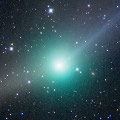
|
It kept as bright as 6-7 mag for a long time from 2011 summer to 2012 spring. Now it is fading. But it is bright as 10.6 mag still now (June 16, Carlos Labordena). It will be unobservable soon in late June. But it will appear in the morning sky again at 12.5 mag in October.
Date(TT) R.A. (2000) Decl. Delta r Elong. m1 Best Time(A, h)
June 23 9 8.57 20 33.1 3.490 2.816 41 10.6 21:04 (107, 11)
June 30 9 12.80 18 59.0 3.637 2.884 36 10.8 21:04 (109, 5)
|
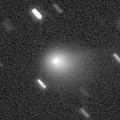
|
Now it is so bright as 10.7 mag (June 14, Juan Jose Gonzalez). It is expected to be bright as 9 mag from 2012 to 2013. In the Northern Hemisphere, it keeps observable in good condition for a long time until 2012 autumn when the comet brightens up to 10 mag. In the Southern Hemisphere, it is hardly observble before the perihelion passage. But it becomes observable in good condition since 2013 after the perihelion passage.
Date(TT) R.A. (2000) Decl. Delta r Elong. m1 Best Time(A, h)
June 23 14 5.92 46 56.3 2.816 3.012 91 11.5 21:04 (138, 73)
June 30 14 3.84 44 33.3 2.803 2.950 88 11.4 21:04 (124, 69)
|

|
Now it is bright as 12.0 mag (June 15, Chris Wyatt). It is expected to be observable at 11-13 mag for a long time from 2012 summer to 2013 summer. It will be observable in excellent condition in the Southern Hemisphere. But it is not observable until 2013 January in the Northern Hemisphere.
Date(TT) R.A. (2000) Decl. Delta r Elong. m1 Best Time(A, h)
June 23 3 30.82 -48 0.8 2.477 2.502 79 12.5 3:00 (310,-29)
June 30 3 49.07 -51 18.0 2.365 2.459 83 12.3 3:03 (315,-28)
|

|
Big asteroid discovered in 1906. It suddenly showed the cometary activity on Dec. 11, 2010, probably due to an impact of a small object. Now it is 11.9 mag (May 29, Marco Goiato). It has already turned to be stellar.
Date(TT) R.A. (2000) Decl. Delta r Elong. m1 Best Time(A, h)
June 23 16 12.42 -23 28.1 1.497 2.450 153 12.4 22:04 ( 0, 31)
June 30 16 8.01 -24 0.2 1.542 2.452 146 12.6 21:32 ( 0, 31)
|
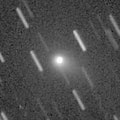
|
It brightened much faster than expected. Now it is so bright as 10.9 mag (June 14, Juan Jose Gonzalez). In the Northern Hemisphere, it keeps observable at 12-13 mag in good condition until early 2013. In the Southern Hemisphere, it is not observable until late 2012.
Date(TT) R.A. (2000) Decl. Delta r Elong. m1 Best Time(A, h)
June 23 8 28.70 72 16.3 2.626 2.166 52 12.6 21:04 (159, 30)
June 30 8 45.35 68 32.5 2.673 2.154 49 12.6 21:04 (156, 28)
|
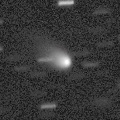
|
It is expected to be a great comet of -1 mag in 2013 spring. Now it is 12.6 mag (June 16, Carlos Labordena). Brightening faster than originally expected. In 2012, it keeps observable until summer while brightening gradually. It locates somewhat low in the Northern Hemisphere.
Date(TT) R.A. (2000) Decl. Delta r Elong. m1 Best Time(A, h)
June 23 15 39.20 -25 37.5 3.320 4.204 146 12.8 21:31 ( 0, 29)
June 30 15 31.16 -25 28.5 3.313 4.123 137 12.8 21:04 ( 2, 29)
|

|
Now it is bright as 12.1 mag (June 14, Juan Jose Gonzalez). It keeps 13-14 mag and observable in good condition until September.
Date(TT) R.A. (2000) Decl. Delta r Elong. m1 Best Time(A, h)
June 23 16 15.13 -12 13.6 4.244 5.157 151 13.5 22:06 ( 0, 43)
June 30 16 5.59 -12 8.8 4.319 5.162 142 13.5 21:29 ( 0, 43)
|
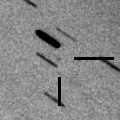
|
It was expected to brighten up to 14 mag from May to July. But actually, it has not been observed since late January. Michael Mattiazzo reported it was not detected, fainter than 17.0 mag, on June 10. In the Southern Hemisphere, it will be getting higher gradually after this. It will be hardly observable in the Northern Hemisphere.
Date(TT) R.A. (2000) Decl. Delta r Elong. m1 Best Time(A, h)
June 23 7 41.84 -47 41.8 0.816 1.117 74 13.5 21:04 ( 53,-38)
June 30 9 23.00 -43 2.0 0.835 1.155 76 13.7 21:04 ( 54,-25)
|

|
This comet brightened up to 10 mag in outburst in 1995, however, it became lost after that. The condition of this apparition is bad. It is not observable around the perihelion passage. Maybe it can be recovered after summer when it appears in the morning sky.
Date(TT) R.A. (2000) Decl. Delta r Elong. m1 Best Time(A, h)
June 23 4 29.56 13 21.0 2.482 1.623 25 13.6 3:00 (247, -9)
June 30 4 48.77 13 41.3 2.503 1.666 27 13.6 3:03 (248, -6)
|
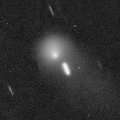
|
Now it is bright as 13.9 mag (June 15, Chris Wyatt). It keeps bright as 13-14 mag for a long time after this until 2013. It is not observable in the Northern Hemisphere, but it is observable in good condition in the Southern Hemisphere.
Date(TT) R.A. (2000) Decl. Delta r Elong. m1 Best Time(A, h)
June 23 4 30.28 -52 45.4 5.706 5.603 79 13.6 3:00 (313,-39)
June 30 4 35.98 -52 32.4 5.699 5.615 80 13.6 3:03 (314,-36)
|
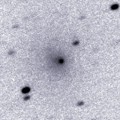
|
Now it is visible visually at 11.7 mag (June 16, Carlos Labordena).
Date(TT) R.A. (2000) Decl. Delta r Elong. m1 Best Time(A, h)
June 23 12 7.42 -10 8.0 6.102 6.255 93 13.9 21:04 ( 53, 27)
June 30 12 9.14 -10 11.4 6.211 6.255 87 13.9 21:04 ( 58, 23)
|
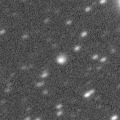
|
Now it is 13.9 mag (Mar. 26, Jakub Cerny). It is expected to be 13 mag and will be observable in good condition in 2013. It keeps observable for a long time in the Northern Hemisphere. It is not observable in the Southern Hemisphere.
Date(TT) R.A. (2000) Decl. Delta r Elong. m1 Best Time(A, h)
June 23 23 15.35 55 19.9 6.478 6.345 77 14.1 3:00 (217, 60)
June 30 23 9.73 55 54.4 6.383 6.327 82 14.0 3:03 (210, 64)
|
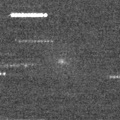
|
Brightening rapidly. It has already brightened up to 14.5 mag (June 18, Michael Jager). It has a large faint coma of 1.5 arcmin. It is expected to reach up to 10 mag in August. It keeps observable in the morning sky all through this apparition, although it locates somewhat low.
Date(TT) R.A. (2000) Decl. Delta r Elong. m1 Best Time(A, h)
June 23 1 20.36 21 46.9 1.173 1.193 65 14.9 3:00 (265, 33)
June 30 1 56.44 23 57.2 1.134 1.136 63 14.2 3:03 (262, 33)
|

|
It kept as bright as 11-12 mag for a long time from 2011 autumn to 2012 spring. It is not observable now. But it will appear in the morning sky again at 15 mag in autumn.
Date(TT) R.A. (2000) Decl. Delta r Elong. m1 Best Time(A, h)
June 23 6 41.80 18 52.1 3.386 2.388 9 14.2 21:04 (128,-17)
June 30 6 56.28 18 31.8 3.424 2.416 6 14.3 21:04 (130,-19)
|

|
Now it is so bright as 11.6 mag (June 14, Juan Jose Gonzalez). Although it was extremely faint as 20.5 mag at the recovery in 2010 autumn, it brightened rapidly. It will keep 12-14 mag and observable in good condition for a long time from 2012 to 2013. But it locates somewhat low in the Northern Hemisphere in 2013.
Date(TT) R.A. (2000) Decl. Delta r Elong. m1 Best Time(A, h)
June 23 12 54.62 9 5.6 2.813 3.105 96 14.3 21:04 ( 59, 49)
June 30 12 57.72 7 60.0 2.891 3.092 91 14.3 21:04 ( 63, 44)
|
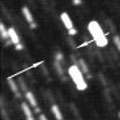
|
Now it is 15.9 mag (June 2, K. Hills). In the Southern Hemisphere, it will be observable at 15-16 mag in good condition for a long time until 2013 summer. It is not observable at all in the Northern Hemisphere.
Date(TT) R.A. (2000) Decl. Delta r Elong. m1 Best Time(A, h)
June 23 20 34.73 -73 30.1 3.235 3.922 126 15.0 2:31 ( 0,-18)
June 30 20 24.15 -75 41.6 3.233 3.914 125 15.0 1:53 ( 0,-21)
|
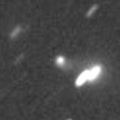
|
Now it is 15.3 mag (May 30, Jakub Cerny). After this, it will be observable in good condition in the Southern Hemisphere while fading gradually. It will locate somewhat low in the Northern Hemisphere. In 2011, some visual observers reported it was very bright as 10-12 mag.
Date(TT) R.A. (2000) Decl. Delta r Elong. m1 Best Time(A, h)
June 23 23 11.72 -16 59.9 2.644 3.129 109 15.0 3:00 (325, 30)
June 30 23 14.68 -17 52.9 2.607 3.177 115 15.1 3:03 (332, 32)
|
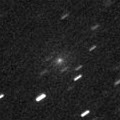
|
Now it is 16.1 mag (May 10, M. Jaeger, et al.). It will brighten up to 13.5 mag from summer to autumn. It keeps observable for a long time until December. In the Northern Hemisphere, it locates high until spring. But after that, it keeps locating low in the evening. In the Southern Henmisphere, it keeps locating low all through the time.
Date(TT) R.A. (2000) Decl. Delta r Elong. m1 Best Time(A, h)
June 23 11 24.61 30 25.4 2.017 1.916 69 15.3 21:04 (101, 43)
June 30 11 35.30 28 59.2 2.006 1.846 66 15.2 21:04 (101, 39)
|
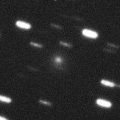
|
It was observed at 12.5 mag on Apr. 1, as bright as expected (Michael Jager). Now it is 14.0 mag (Apr. 26, Michael Jager). In the Northern Hemisphere, it locates extremely low in the morning until June. It will be observable at high location after summer. In the Southern Hemisphere, it will never be observable again.
Date(TT) R.A. (2000) Decl. Delta r Elong. m1 Best Time(A, h)
June 23 3 53.51 44 5.0 3.298 2.525 34 15.3 3:00 (227, 16)
June 30 4 8.51 44 38.2 3.337 2.598 37 15.5 3:03 (228, 19)
|
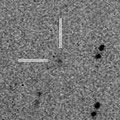
|
First return of a new periodic comet which brightened up to 14 mag in 2005. It was recovered as bright as predicted. Now it is 17.5 mag (May 18, Martin Masek). It is expected to brighten up to 13 mag from summer to autumn, and will be observable in excellent condition. Now it locates high in the Southern Hemisphere.
Date(TT) R.A. (2000) Decl. Delta r Elong. m1 Best Time(A, h)
June 23 23 59.97 -13 2.3 1.281 1.728 96 15.9 3:00 (311, 27)
June 30 0 13.85 -10 51.4 1.198 1.694 99 15.6 3:03 (313, 31)
|
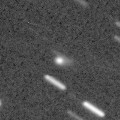
|
Now it is 15.8 mag (June 10, K. Hills). It keeps observable in good condition at 14-15 mag for a long time until winter. It locates somewhat low in the Southern Hemisphere.
Date(TT) R.A. (2000) Decl. Delta r Elong. m1 Best Time(A, h)
June 23 23 28.13 32 39.9 3.479 3.543 85 15.7 3:00 (264, 60)
June 30 23 33.38 33 49.3 3.374 3.514 89 15.6 3:03 (264, 66)
|

|
Brightening rapidly. Now it is 17.2 mag (June 8, K. Hills). It will approach to the earth down to 0.17 A.U. in July. Then it brightens up to 15 mag and moves northwards very quickly. Now it locates very high in the Southern Hemisphere. In the Northern Hemisphere, it will become observable in late June, then it will be observable in excellent condition. In the Southern Hemisphere, it keeps excellent condition until July. It keeps observable also after that, but locates somewhat low.
Date(TT) R.A. (2000) Decl. Delta r Elong. m1 Best Time(A, h)
June 23 18 19.85 -44 30.1 0.220 1.224 158 16.1 0:15 ( 0, 10)
June 30 18 30.65 -32 47.1 0.189 1.203 170 15.7 0:00 ( 0, 23)
|

|
The condition of this apparition is bad, and it was not observable around the perihelion passage. Appearing in the morning sky now. It is bright still now, about 14 mag (May 16, Terry Lovejoy). But it still locates extremely low in the Northern Hemisphere.
Date(TT) R.A. (2000) Decl. Delta r Elong. m1 Best Time(A, h)
June 23 1 30.91 0 52.9 2.432 2.304 70 15.7 3:00 (283, 20)
June 30 1 39.13 1 32.7 2.389 2.343 75 15.8 3:03 (286, 24)
|
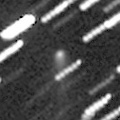
|
Now it is 16.5 mag (June 14, L. Arnold). It is expected to approach to the earth and to be observable at 9-10 mag in good condition in winter. The condition is good in the Northern Hemisphere. It locates low in the Southern Hemisphere, and will be unobservable after summer. But it will become observable in good condition after 2013 January.
Date(TT) R.A. (2000) Decl. Delta r Elong. m1 Best Time(A, h)
June 23 18 27.50 40 19.3 1.951 2.566 116 16.5 0:24 (180, 85)
June 30 18 7.16 43 3.7 1.901 2.487 113 16.4 23:29 (180, 82)
|
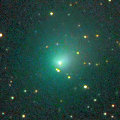
|
It brightened up to 10 mag from autumn to winter in 2011. Now it is appearing in the morning sky again in the Southern Hemisphere. It keeps observable in good condition while fading graudlaly after this. It will be hardly observable in the Northern Hemisphere.
Date(TT) R.A. (2000) Decl. Delta r Elong. m1 Best Time(A, h)
June 23 4 31.85 -15 27.4 4.483 3.838 45 16.5 3:00 (271,-26)
June 30 4 37.10 -16 35.3 4.483 3.898 49 16.6 3:03 (275,-22)
|
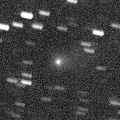
|
Now it is 15.5 mag (June 8, Catalina Sky Survey). It tends to brighten after the perihelion passage. It keeps observable at 16-17 mag from 2012 to 2013. It locates somewhat low in the Northern Hemisphere.
Date(TT) R.A. (2000) Decl. Delta r Elong. m1 Best Time(A, h)
June 23 16 11.09 -16 18.9 2.185 3.118 151 16.7 22:03 ( 0, 39)
June 30 16 8.08 -16 36.8 2.232 3.117 144 16.7 21:32 ( 0, 38)
|
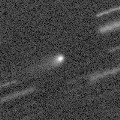
|
Now it is 16.6 mag (June 12, Catalina Sky Survey). It keeps observable at 17 mag for a long time from 2011 to 2013. In 2012, it keeps observable in good condition until early September.
Date(TT) R.A. (2000) Decl. Delta r Elong. m1 Best Time(A, h)
June 23 14 37.55 8 26.8 5.056 5.627 119 17.0 21:04 ( 19, 62)
June 30 14 31.35 8 18.0 5.165 5.630 112 17.1 21:04 ( 35, 59)
|
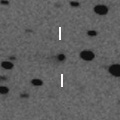
|
It keeps 17 mag for a long time from 2009 to 2013.
Date(TT) R.A. (2000) Decl. Delta r Elong. m1 Best Time(A, h)
June 23 23 36.70 14 23.1 8.261 8.344 91 17.3 3:00 (291, 50)
June 30 23 34.43 14 27.4 8.152 8.356 98 17.3 3:03 (300, 56)
|

|
Now it is 20.0 mag (May 27, Hidetaka Sato), much fainter than expected. But it is expected to brighten rapidly, and to be observable in good condition at 16.5 mag from summer to autumn.
Date(TT) R.A. (2000) Decl. Delta r Elong. m1 Best Time(A, h)
June 23 23 28.62 -9 47.2 1.725 2.188 102 17.6 3:00 (316, 34)
June 30 23 34.96 -8 20.7 1.636 2.170 107 17.4 3:03 (321, 38)
|
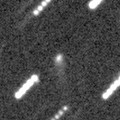
|
New comet. Now it is 17.2 mag (June 5, A. Diepvens). It will brighten up to 15 mag from autum to winter. In the Northern Hemisphere, it keeps observable for a long time until the comet fades out. It is not observable in the Southern Hemisphere, except for 2013 spring, but the comet locates extremely low only.
Date(TT) R.A. (2000) Decl. Delta r Elong. m1 Best Time(A, h)
June 23 18 37.85 74 37.1 3.027 3.054 81 17.8 0:34 (180, 50)
June 30 18 3.17 76 26.6 3.004 3.004 80 17.7 23:23 (180, 48)
|
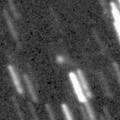
|
New comet. Now it is 17.1 mag (June 4, A. Diepvens). It is expected to brighten up to 10 mag from winter to spring in 2013. In the Northern Hemisphere, it keeps observable in good condition until 2013 April. It is not observable now in the Southern Hemisphere. It will become observable after 2013 April, but it keeps locating low.
Date(TT) R.A. (2000) Decl. Delta r Elong. m1 Best Time(A, h)
June 23 0 8.25 72 57.1 4.425 4.146 67 17.9 3:00 (197, 46)
June 30 0 19.81 74 29.8 4.334 4.079 68 17.8 3:03 (195, 46)
|
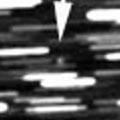
|
New comet. Now it is 17.4 mag (June 12, L. Elenin). Now it is brightest. It will be fainter than 18 mag very soon.
Date(TT) R.A. (2000) Decl. Delta r Elong. m1 Best Time(A, h)
June 23 19 55.22 36 46.5 2.491 3.058 114 17.8 1:51 (180, 88)
June 30 19 32.49 36 18.7 2.437 3.063 119 17.8 1:01 (180, 89)
|
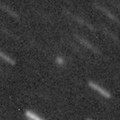
|
New periodic comet. Now it is 18.1 mag (June 18, Hidetaka Sato). It is observable at 18 mag in good condition from June to July.
Date(TT) R.A. (2000) Decl. Delta r Elong. m1 Best Time(A, h)
June 23 16 54.05 -5 48.8 1.250 2.213 155 17.9 22:45 ( 0, 49)
June 30 16 49.78 -6 40.3 1.259 2.196 149 17.9 22:14 ( 0, 48)
|

|
New comet. Now it is 17.9 mag (May 30, K. Hills). It will brighten up to 15.5 mag in 2013 spring. In the Southern Hemisphere, it keeps observable in good condition while the comet will be brightening gradually. In the Northern Hemisphere, it is not observable until 2013 spring.
Date(TT) R.A. (2000) Decl. Delta r Elong. m1 Best Time(A, h)
June 23 21 29.35 -73 40.4 3.890 4.526 123 18.0 3:00 (358,-19)
June 30 20 57.80 -75 24.0 3.827 4.485 124 17.9 2:27 ( 0,-20)
|
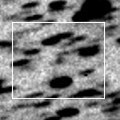
|
It was predicted to brighten up to 17 mag and will be observable in good condition from spring to summer. But actually, it is so faint as 19.5 mag, much fainter than expected (June 16, Michael Jager).
Date(TT) R.A. (2000) Decl. Delta r Elong. m1 Best Time(A, h)
June 23 19 28.37 -5 31.4 1.279 2.235 153 18.8 1:24 ( 0, 49)
June 30 19 23.74 -5 32.8 1.277 2.256 159 18.8 0:52 ( 0, 49)
|
|
![]()
 C/2009 F4 ( McNaught )
C/2009 F4 ( McNaught ) 29P/Schwassmann-Wachmann 1
29P/Schwassmann-Wachmann 1 C/2010 S1 ( LINEAR )
C/2010 S1 ( LINEAR ) 185P/Petriew
185P/Petriew 78P/Gehrels 2
78P/Gehrels 2 246P/2010 V2 ( NEAT )
246P/2010 V2 ( NEAT ) C/2011 O1 ( LINEAR )
C/2011 O1 ( LINEAR ) C/2011 A3 ( Gibbs )
C/2011 A3 ( Gibbs ) C/2012 CH17 ( MOSS )
C/2012 CH17 ( MOSS ) C/2011 Q2 ( McNaught )
C/2011 Q2 ( McNaught ) 260P/2012 K2 ( McNaught )
260P/2012 K2 ( McNaught ) C/2012 J1 ( Catalina )
C/2012 J1 ( Catalina ) 189P/NEAT
189P/NEAT 71P/Clark
71P/Clark C/2012 K5 ( LINEAR )
C/2012 K5 ( LINEAR ) C/2010 G2 ( Hill )
C/2010 G2 ( Hill ) 152P/Helin-Lawrence
152P/Helin-Lawrence C/2010 R1 ( LINEAR )
C/2010 R1 ( LINEAR ) C/2008 S3 ( Boattini )
C/2008 S3 ( Boattini ) 160P/LINEAR
160P/LINEAR C/2012 L1 ( LINEAR )
C/2012 L1 ( LINEAR ) C/2012 L2 ( LINEAR )
C/2012 L2 ( LINEAR ) C/2012 L3 ( LINEAR )
C/2012 L3 ( LINEAR ) P/2012 K3 ( Gibbs )
P/2012 K3 ( Gibbs ) C/2012 K6 ( McNaught )
C/2012 K6 ( McNaught ) 105P/Singer Brewster
105P/Singer Brewster![]()































